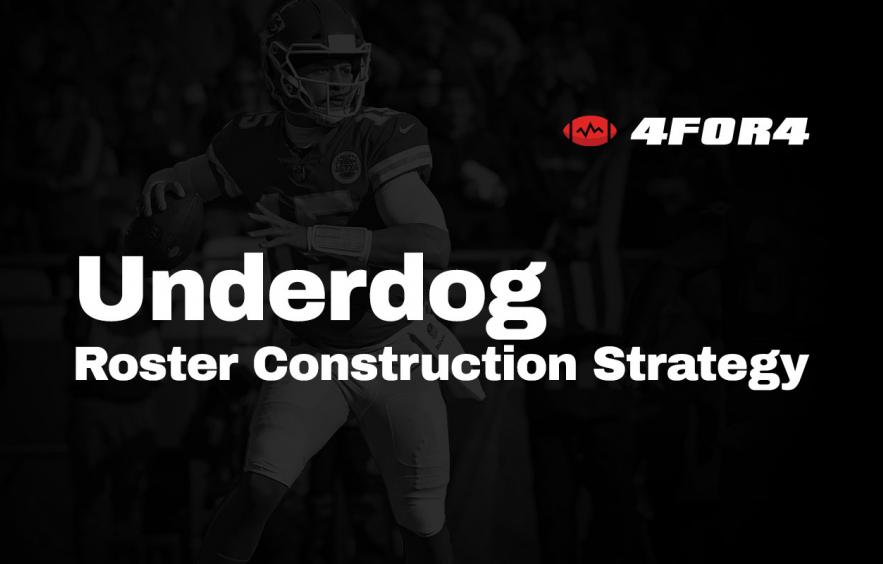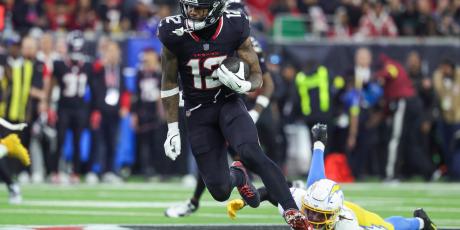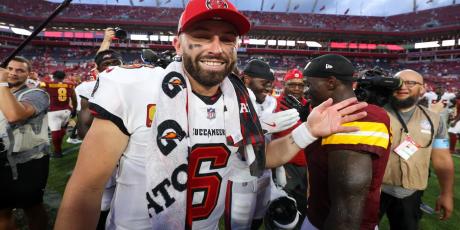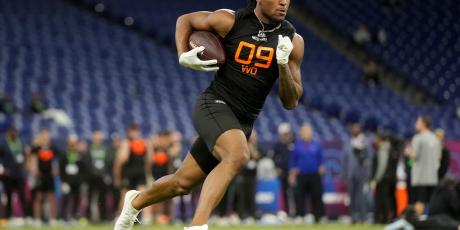Underdog Best Ball Mania II Roster Construction Strategy

Best ball fantasy football leagues require an especially nuanced draft strategy since there are no in-season transactions. The ramifications of proper draft planning are amplified in huge tournament formats such as Underdog Fantasy’s Best Ball Mania II where over 155,000 entries are competing for a $1 million (and one) dollar first prize.
Underdog Fantasy Resources: Get a Free Pro Subscription | Half PPR Rankings | Roster Construction Strategy | ADP Risers/Fallers & Cheap Stacks | More Best Ball Content
Arguably the most important concept to understand when drafting a best ball team is positional allocation, more commonly known as roster construction. How many players you draft at each position directly impacts the floor of a team that can’t be changed once the draft is over—more importantly in this format, it impacts your ceiling.
Underdog leagues are half-PPR, 18-man rosters that start: QB, RB, RB, WR, WR, WR, TE, Flex (RB/WR/TE). There are no kickers or team defenses. Best Ball Mania II allows up to 150 entries per person and the tournament consists of four rounds:
- Round 1 - 12 person groups
- Round 2 - 18 person groups
- Round 3 - 18 person groups
- Round 4 - 160 person groups
See the full rules explanation here.
For our purposes, the important thing to know is that in order to have any chance at the top prize, you first must win your 12-team league. To see which roster construction techniques are optimal, 4for4’s Kevin Zatloukal helped me pull data from the 2,834 drafts that took place for Underdog’s 2020 Best Ball Mania I. We examined the positional allocation for each league-winner to give you a guide on how to build your Best Ball Mania II roster.
Quarterbacks
Among all league winners from last year’s tournament, the most popular roster construction (13.9% of winners) was: 2QB/6RB/8WR/2TE. The caveat here is that this was also the most popular positional allocation overall, with 13.2% of all teams using this positional makeup.
A zoomed-out look shows that the top-10 roster constructions in terms of percentage of league winners rostered 2–3 quarterbacks. Of the 2,834 winners, just 27 teams rostered four quarterbacks.
As is the case with every position, deciding on the high or low range is often dependent on draft capital—team managers that draft a quarterback relatively early can typically opt for a 2-QB approach while those that wait on the position should usually favor a 3-QB build. This general rule might be ignored when managers are targeting specific team stacks, a strategy that will be covered in a later article. A team that invested in an early quarterback but missed out on stacking him or their second quarterback with one of their pass-catchers might pull the trigger on a third quarterback to match up with a pass-catcher that was taken earlier in the draft.
Suggested roster construction: 2–3 quarterbacks
Running Backs
Because of Underdog’s half-PPR format, new best ball drafters might be inclined to load up on running backs, but roster requirements demand more wide receivers than running backs. With that, the top three most popular roster constructions drafted just six running backs with the next three most popular builds rostering only five running backs. Those top six builds accounted for two-thirds of league winners.
Beyond the 5–6 running back parameters, we see that just over 10% of winners used a 7-RB roster and 1.1% had an 8-RB lineup. Fewer than 6% of winners had a team with four running backs.
Later strategy pieces will discuss where in the draft winners took their running backs, but it stands to reason that the earlier you take your running backs, the fewer backs that you can take. Intuitively, a late-round running back approach should be tough to execute in a best ball format since strategies such as Zero RB rely heavily on the waiver wire but there is evidence that waiting to draft multiple running backs can still be profitable in no-transaction leagues such as Best Ball Mania II.
Suggested roster construction: 5–6 running backs
Wide Receivers
In addition to this format requiring more wide receivers than running backs, there are simply more fantasy-viable receivers than backs. In any given week, a team usually has one running back that is expected to put up relevant fantasy numbers while almost any offense in the NFL can conceivably have three wideouts that might go off.
The range for wide receiver roster construction is wider than any other position, with the most popular winning design using eight receivers while the other top-four builds chose seven at the position. Additionally, one of the top-10 most popular winning strategies used just six receivers while another in the top 10 opted for nine.
Data that points to a wide-receiver-heavy approach in the early rounds combined with this being an incredibly deep position allows for plenty of strategies but more is usually better, given wide receivers’ weekly ceilings. As mentioned with quarterbacks, there should be a focus on pairing pass-catchers with their passers in some manner.
Suggested roster construction: 7–8 wide receivers, 9 in rare instances (2QB/2TE teams for example)
Tight Ends
There are no absolute truths in fantasy football (except that there are no absolute truths) but drafting a top tight end has been one of the most profitable strategies in recent years, at least when it comes to winning 12-man best ball leagues. The advantage that a Travis Kelce or George Kittle offers over the field is tremendous and has been reflected in win rates. In the cases where a team is fortunate enough to land a top three or four tight end, settling on just two players at the position usually suffices.
Of course, the supply of top-tier tight ends is limited, which is why three of the five most popular roster builds had three players at the position. It’s important to remember that upside is king in large-field tournaments. While few players can match the weekly output of a Kelce, there are plenty of tight ends with boom potential that might even find their way into the Flex a few times a season—don’t be scared to grab three at a position that some drafters might be shy to load up on. Don’t get carried away at this position, though—out of the 2,834 leagues sampled, just 26 winners rostered four tight ends.
Suggested roster construction: 2-3 tight ends
The Bottom Line
Data from 2020’s Best Ball Mania I gives us great insight on how to plan our drafts for Underdog’s Best Ball Mania II. Each position has a tight range of players to draft and that roster construction will give drafters an edge over league managers that are unaware of the premise. Whether a fantasy manager ends up on the low or high end of the allocation range for a given position is largely dependent on draft capital spent there but can also be influenced by strategies such as team stacking.
Drafters should be looking to stay in these ranges when drafting their tournament teams:
- Quarterbacks: 2–3
- Running Backs: 5–6
- Wide Receivers: 7–8
- Tight Ends: 2–3
For those curious about specific team builds, here are the top 25 roster constructions from 2020 league winners:
| Quarterbacks | Running Backs | Wide Receivers | Tight Ends | % of BBM1 League Winners |
|---|---|---|---|---|
| 2 | 6 | 8 | 2 | 13.9% |
| 3 | 6 | 7 | 2 | 11.0% |
| 2 | 6 | 7 | 3 | 10.8% |
| 3 | 5 | 7 | 3 | 10.8% |
| 2 | 5 | 8 | 3 | 10.1% |
| 3 | 5 | 8 | 2 | 8.5% |
| 3 | 6 | 6 | 3 | 7.0% |
| 2 | 7 | 7 | 2 | 6.4% |
| 2 | 5 | 9 | 2 | 6.3% |
| 3 | 4 | 8 | 3 | 2.1% |
| 2 | 7 | 6 | 3 | 2.0% |
| 2 | 4 | 9 | 3 | 1.6% |
| 3 | 7 | 6 | 2 | 1.5% |
| 2 | 4 | 10 | 2 | 1.1% |
| 2 | 8 | 6 | 2 | 0.9% |
| 3 | 4 | 9 | 2 | 0.9% |
| 3 | 7 | 5 | 3 | 0.4% |
| 4 | 6 | 6 | 2 | 0.4% |
| 4 | 5 | 6 | 3 | 0.3% |
| 2 | 5 | 7 | 4 | 0.3% |
| 4 | 5 | 7 | 2 | 0.3% |
| 3 | 4 | 7 | 4 | 0.3% |
| 2 | 6 | 6 | 4 | 0.2% |
| 3 | 5 | 6 | 4 | 0.2% |
| 3 | 8 | 5 | 2 | 0.2% |























